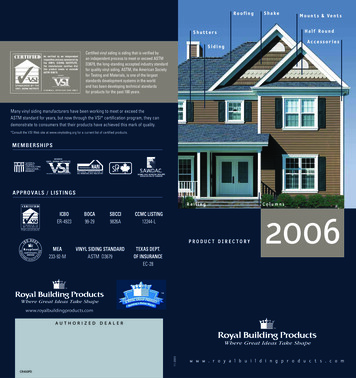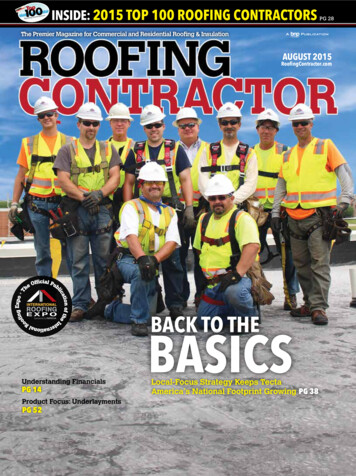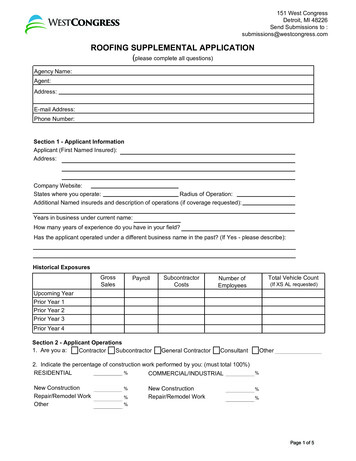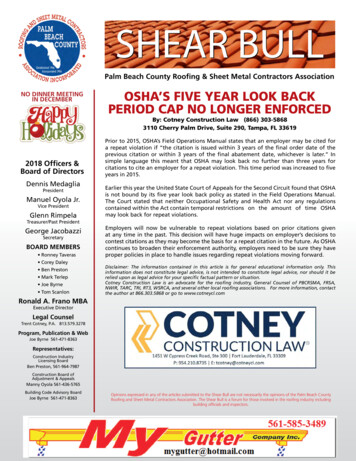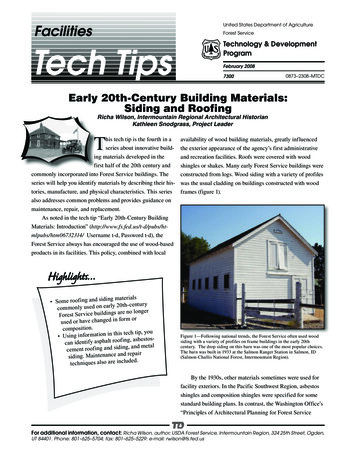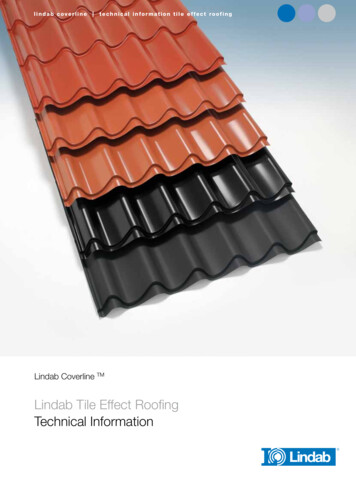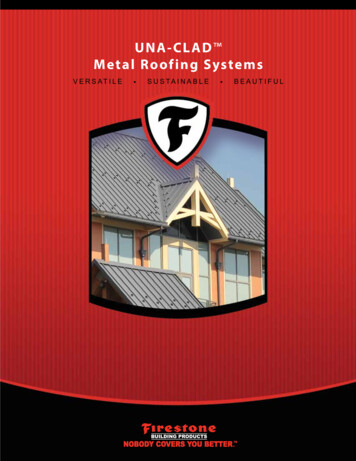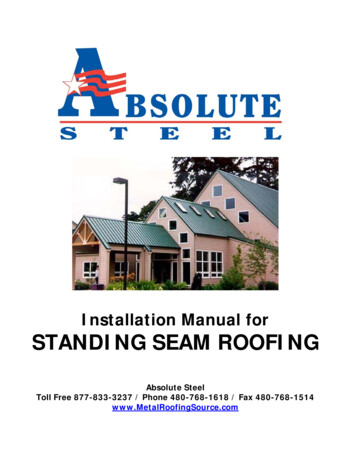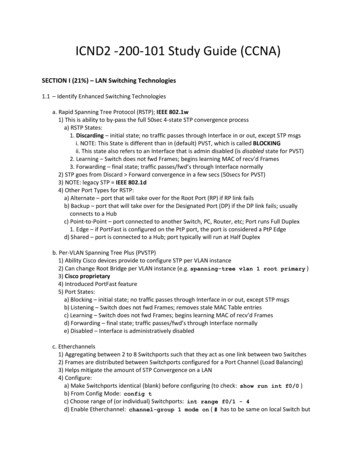
Transcription
CUSTOMER SERVICE GUIDERoofing 101:What Every Homeowner Must KnowAbout Their Roofing Installation
Table of Contents3Welcome4The Larry Haight’s Story5Reasons to Replace your Roof7Glossary of Roofing Terms9Questions to Ask your Roofing Contractor
“Quality craftsmanship is learnedthrough education, training andexperience, which directly affects theoutcome of your roof installation.”WelcomeAt Larry Haight’s Residential Roofing, we maintaina high level of professionalism, integrity,honesty, and fairness in our relationships with ourcustomers, employees and suppliers. Customersatisfaction in all areas is key toensure the future growth of ourcompany through repeat andreferral business.95%Your roof providesprotection for 95% ofyour investmentYour roof constitutes only fivepercent of the construction cost ofyour home yet provides protectionfor 95% of your investment. When it is time toreplace your roof, you want it done right! Contractorselection and the roofing material are importantdecisions a homeowner makes when replacing yourroof.Roof application is not an exact science; it is a“craft” involving people who juggle a broad rangeof building materials, designs, techniques, andweather. The quality of application is a directreflection of who installs your roof.You can’t afford to have your roof system installedby amateurs or by a company who “pick up” workerseach day. Quality craftsmanship is learned througheducation, training and experience, which directlyaffects the outcome of your roof installation.“Roof application is not an exact science; it is a “craft”4 2 5 -8 8 1 -9771W W W. L A R RY H A I G H T.C O M3
The Larry Haight’s StoryBeginning my business was a true leap of faith. I had adaughter starting college and a son in high school. Finances were tight, but I knew this was what I should be doing. Igrew up in a roofing family, took a break to learn how a business operates, then began my own at the age of 43. Scared,yes. Determined, yes. Stubborn to succeed, even more so!Back then contractors weren’t the most upstanding individuals. I recognized a need for a reputable roofing contractorin the Puget Sound area. So I began my journey. Literally,I was a one man show—truly, one man, one ladder, andone truck. The details of how the job was executed neverbothered me. I knew if I didn’t do what I said I was going todo, I would be seen like the other failed contractors.full ofempty promises. That is not how I wanted my company tobe viewed, simply because that is not how I run my personalaffairs.I started my shop in an “A” frame cabin that sat along 1-90in Issaquah. Now, in its place sits a Chevrolet dealership.My long-time friend designed my sign that stood in front ofmy first office (that very logo still exists). Everything was inplace.but I needed to get the phone ringing.4 2 5 -8 8 1 -9771I remember at one point, staring at the phone, willing it toring, knowing full well someone would call me. In the beginning, I had a lot of time to think about how to get my nameout to folks. How did I want my customers to view myservice? The million dollar question. Even today, I feel thesame way as I did back then. I want customers to think ofmy company as my friends see me—hard working, honest,and reliable. Not much has changed.Beginning a business is tough. My stories are endless.From being called at 11PM one evening to pick up 5 nails insomeone’s grass to receiving my first plate of cookies froma young family who was pleased with what my companydid for them.It’s about treating people fairly—you know the golden rule:Do unto others as they would do unto you. I taught my children that way and I treat my employees just the same. andevery customer who walks though my business door.I love what I do because I do what I love. To me, there isn’tanything better than looking at a job well done.and I get todo that regularly!W W W. L A R RY H A I G H T.C O M4
Reasons to ReplaceYour RoofSpotting worn out shingles and shakesOver time the material on your roof will split,curl and buckle. Aging material leads to failuresin protecting your home from the Puget Soundweather. Rafter lines will appear when plywoodbegins to delaminate.Missing MaterialAside from making your roof look unattractive,missing roofing material creates opportunitiesfor water to enter your home. High wind, poormaterial installation, and time weakens thestrength of your roof’s shingles.Moss GrowthMoss on your roof isn’t like having your owneco- friendly green roof. Over time, moss breaksdown and compromises the integrity of the shingle, be it composition or wood. Moss travels onthe tiniest speck of dirt, lands on your roof andgrows, grows, grows. Annual moss removal is amust on your check list in maintaining your roof.5
Reasons to ReplaceYour Roof (continued)Interior SignsLooking in your attic is a great way to see theeffectiveness of your roof’s ability to breathe andfunction. In essence, you are inspecting your roof theinside out. Ceiling stains appear when your roof allows waterto enter for a variety of reasons such as roof age,missing material, flashing failure, or punctures toyour roof. Another sign to watch for is wet insulation. Wetinsulation loses its effectiveness making yourheating system work harder to keep your home warm and cool. Wet anything in your attic space is aninvitation for mold and mildew growth. Spotting black mold is never a comforting sight. Attic mold is attributed to insufficient air flow fromeaves to roof line. As shown in the diagram below air should travel from the soffits through your atticspace and out the ridge line of your roof. Efficient ventilation begins with a proper roof installation.Algae StainingHave you noticed black stains on your roof?That is algae staining. The algae spore, likemoss, takes root on your roof spreading toform black triangular shapes on your shingles.With our moist climate, algae is severe inthe Puget Sound area. There are treatmentsavailable to remove these stains.Remember, never POWER WASH your roof!!6
Glossary of Roofing TermsBarge Board — a boardthat conceals roof timbersprojecting over gablesCounter Flashing — thatportion of the flashingattached to a verticalsurface to prevent waterfrom migrating behind thebase flashingCornice — the overhanging part of the roof (thepart that sticks out pastthe walls)Cricket — the evaluationof a part of a roof surfaceas a means of promotingdrainage of water frombehind an obstacle suchas the chimneyin a vertical position to protect the edge of the roofassemblyCurb — a short wall or masonry built above thelevel of the roof; it provides a means of flashing thedeck equipmentDeck — the base surface to which a roof system isappliedDrip Edge — a device designed to prevent waterfrom running back or under an overhangEdge Metal — a term relating to brake or extrudedmetal around the perimeter of a roofEave — the part of a roof which projects out fromthe side wall, or the lower edge of the part of a roofthat overhangs a wallFascia — any cover board at the edge or eaves ofa flat, sloping, or overhanging roof, which is placed4 2 5 -8 8 1 -9771Felt — a very general term used to describe composition of roofing ply sheets, consisting of a mat oforganic or inorganic fibers unsaturated, impregnated with asphalt or coal tar pitch, or impregnatedand coated with asphaltFlashing — connecting devices that seal membranejoints at expansion joints, walls, drains, gravelstops, and other places where the membrane isinterrupted or terminatedGable — triangular roofGutter — a narrow channel, or trough, forming thecomponent of a roof system, which collects anddiverts rainwater shed by the roof HIP ROOF — aroof which rises by inclining planes from all foursides of a buildingW W W. L A R RY H A I G H T.C O M7
Ridge Vent — A ridge vent runs the entire length ofthe roof peak, blending into the roofline for a moreattractive homeRidge Shingles — shingles used to cover the horizontal external angle formed by the intersection oftwo sloping roof planesRoof Deck — a component in building construction,which forms a platform on which the remainder ofthe BURM components are placedSheathing — the boards of sheet type material,plywood or asphalt saturated sheets, nailed tostudding or roofing rafters as the base for application of the roof coveringSkylight — A flat or sloped window built into a roofstructure for day lightIce Dam — condition formed at the lower roof edgeby the thawing and re-freezing of melted snow onthe overhang. Can force water up and under shingles, causing leaksOSB — Oriented Strand Board; a decking madefrom wood chips and lamination glues PLUMBINGVENT—(SOIL PIPE VENT) consists of pipes leadingfrom fixtures to the outdoors, usually via the roof.Vents provide for relief of sewer gases, admission of oxygen for aerobic sewage digestion, andmaintenance of the trap water seals which preventsewer gases from entering the homePlywood — thin layers of boards that are glued,compressed and laminated to create a thickerboard; thin layers of wood placed together with thegrain of each layer at right angles to the adjacentlayerRafter — parallel beams that support a roof (similarto how joists support floors and ceilings)Rake — the angle of slope of a roof rafter, or theinclined portion of a corniceRidge — the uppermost, horizontal external angleformed by the intersection of two sloping roofplanes4 2 5 -8 8 1 -9771Slope — incline or pitch of roof surfaceSoffit — the underside of a part or member of abuilding extending out from the plane of the building wallsSoffit Ventilation — intake ventilation installedunder the eaves, or at the roof edgeSquare — a term used by the roof industry to indicate an amount of roof area equal to 100 squarefeetStep Flashing — flashing application method usedwhere a vertical surface meets a sloping roof planeTear Off — a term used to describe the completeremoval of the built up roof membrane and insulation down to and exposing the roof deckTruss — a framework of beams (like ribs) thatsupport the roof (usually triangular)Valley — a depressed angle formed by the meetingof two inclined slopes of a roofVenting — a process of installing roof vents in a roofassembly to relieve vapor pressure; types of ventilation include: ridge (attic), soffit, and plumbingW W W. L A R RY H A I G H T.C O M8
Questions To Ask Your ContractorWanting to hire a good, reputable contractor? Of course, we all do. Use this document to find out howto weed through the good from the bad. Do a little research prior to calling for an estimate or ask yourcontractor face to face. It is a good idea to know who are dealing with, after all these folks will be workingon your home.Print this document to use during your sales presentation for each contractor; note sections are available. What is the business history of the contractor?» Does the contractor hold a valid/current license for our state?» Does the contractor carry workman’s compensation, property damage and liability insurance?» Has the contractor ever claimed bankruptcy? Changed their name? If so, how many times and why?Research: Look for their physical location to make sure their address is correct. Check out the Laborand Industry to view the contractor’s information and business history. The website is www.lni.wa.govNotes: Ask for a recent list of references.Don’t be shy, drive by the addresses provided by the company to see their work, if the homeowner is out,talk to them about their experience with the company you want to hire.Notes: Ask for an itemized estimate of the proposed scope of work.Always get your project in writing, and make sure you understand what the project entails, aka, ask a lotof questions.4 2 5 -8 8 1 -9771 What if the project requires more work than initially estimated.how does the contractor handlechange orders? Does the company clean the project area when completed?W W W. L A R RY H A I G H T.C O M9
Questions To Ask Your Contractor (continued)Notes: What is a Lien Release, and why would I need one? A lien release is a document from the contractor’s supplier stating if the contractor you hireddoesn’t pay their bill, you are not responsible. Any good contractor will do this as a courtesy for allof their customers, don’t accept any excuses on this one!Notes: What GUARANTEES can the contractor provide? Does the contractor have warranties? If so, what are they? Can your contractor provide the warranties in writing?Notes: Who will oversee my roofing project? Does the company provide an on-site supervisor? If so, who is the supervisor? Will someone other than that supervisor inspect the progress daily? ASK THIS: Is a Permit needed for my project? All necessary permits should be obtained by theroofing contractor and signed off by the roofing contractor.Notes:4 2 5 -8 8 1 -9771W W W. L A R RY H A I G H T.C O M10
Questions To Ask Your Contractor (continued) If I sign with you, what are your communication policies prior to the project beginning? How will I be notified when my project will begin? What is you daily routine?Notes: How will you protect my home? Does your written contract include a statement detailing items your contractor isn’t responsiblefor, such as windows, siding, doors, plants, trees.?Notes: What is the payment plan? How much do you need upfront? What are the payment terms once the project is complete? Do you conduct a final inspection with homeowners?Notes:4 2 5 -8 8 1 -9771W W W. L A R RY H A I G H T.C O M11
Thank you for taking the time to read our guide.We hope this provides you with valuable informationregarding the state of your home’s roof.Our Services Include: Roof Replacement Gutters Skylights Roof RepairWe look forward to serving your roofing needs in the future.
At Larry Haight’s Residential Roofing, we maintain . a high level of. professionalism, integrity, honesty, and. fairness. in our relationships with our . customers, employees and suppliers. Customer satisfaction in all areas is key to ensure the future growth of our company through repeat and
